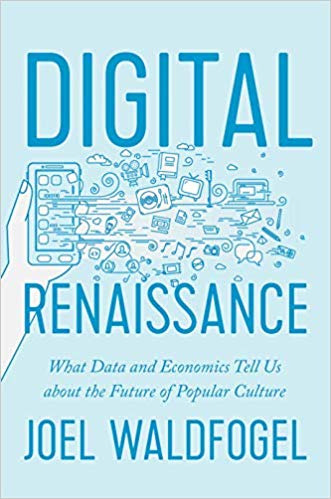You have /5 articles left.
Sign up for a free account or log in.
 Digital Renaissance: What Data and Economics Tell Us about the Future of Popular Culture by Joel Waldfogel
Digital Renaissance: What Data and Economics Tell Us about the Future of Popular Culture by Joel Waldfogel
Published in November of 2018.
Do you remember when our biggest campus tech worry was our students using our networks to download music and movies illegally?
It seemed like only yesterday when all we could talk about was the RIAA (Recording Industry Association of America) and the Motion Picture Association of America (MPAA) student lawsuits.
(I don’t know what happened to RIAA student settlement offers. Do we have an account of how many students ended up paying settlements?)
Back in the days of Napster and Grokster, it would have been hard to argue that the internet was good for the creative industries. The ease in which anyone with a computer and a fast (university) web connection could discover and download an MP3 for zero cost was a kill shot to a recording industry selling $20 CDs. Fast dorm room connections made stealing movies as easy for students as downloading songs was for everyone else.
From the perspective of the early 2000s, an entirely plausible argument could have been made that the internet (and digital file-sharing) would eventually do to movie studios and TV networks and book publishers the same thing that it was doing to the music labels. The digital destruction of the creative industries seemed like a genuine possibility.
How different things look in 2018. Instead of destroying the creative economy, we are instead living through a digitally mediated creative renaissance.
At least that is the argument that economist Joel Waldfogel makes in his persuasively data-driven new book Digital Renaissance.
Waldfogel is a data nerd’s data nerd. If you love charts, tables, graphs, and numbers than you will very much enjoy Digital Renaissance.
This is not nonfiction in the Gladwell/Stewart popular nonfiction genre. This is not a book that builds it case from stories of quirky individuals fighting the conventional wisdom. Waldfogel is more likely to be a protagonist is a Malcolm Gladwell or James Stewart (or Heath brothers) book than an emulator of their style.
Waldfogel builds an airtight case that, despite persistent worries that digital is incompatible with creative output, that we have never had it so good.
The argument that digital is beneficial to the creative industries is most surprising when it comes to music. Waldfogel does not shy away from reporting on the destruction that Napster brought to the recording industry. In 1999 recorded music sales in the U.S. were about $21 billion (in constant dollars). By 2015 that figure had dropped to about $7 billion.
So is the music industry a third as large today as it was in 1999? Hardly. By 2017 revenue from streaming has far surpassed that of recorded music. Today, record companies are making more money than ever - just not from sales of CDs or other physical media. Streaming and music download purchases now account for almost twice the sales of recorded music.
Please tell me if I’m wrong, but my understanding is that the reason that we don’t talk about the RIAA suing our students nowadays is that our students are now mostly getting their music from Spotify, Pandora, Apple, and Amazon.
Of course, revenues are only part of the story. Waldfogel goes to great trouble to build a case that the quality of music (and other creative outputs) has also improved. He bases this conclusion on every conceivable measure of critical and user reviews.
One reason that quality has gone up is that the production costs for creative output and distribution have gone down. Music, video, and books can be produced and distributed for the price of a laptop and some software.
Nor does Waldfogel neglect the question if the flood of digitally produced and searchable content is good for consumers. We all seem to be able to navigate the long tail of digitally delivered music, movies, shows, and books just fine.
The chapters of Digital Renaissance that cover music, movies, and TV are the strongest. Waldfogel enthusiasm for all things pop culture is abundantly apparent, even among the tsunami of graphs and charts that he unleashes.
I found the chapter on the book industry less satisfying. The focus is mostly on e-books and the proliferation of digital self-publishing. To my surprise and dismay, Waldfogel completely ignores audiobooks.
The reason that we are in a book reading renaissance has everything to do with audiobooks and the integration of e-books and audiobooks. (I purchased the Whispersync for voice enabled Kindle and Audible book versions of Digital Renaissance, meaning that I seamless went back and forth between reading with my eyes and my ears).
In ignoring how integrated audiobooks/e-books have opened up new possibilities for reading, Waldfogel also misses the worrying side of this story. If he had written about Whispersync, Waldfogel could have also talked about the dangers of an Amazon monopoly.
He also could have written about digital media can be a drive of social inequality. No library that I know about is loaning out the Whispersync versions of books. The life-changing experience of syncing e-books and audiobooks is only available to those with the disposable income to pay for this privilege.
As a digital education person, I also wish that Waldfogel would have turned his digital renaissance lens back on the industry in which he works. While I enjoyed the chapter on travel agents and photographers, what about a chapter on universities and professors?
Despite these complaints, if you are interested in where culture and technology come together, then Digital Renaissance is a must read.
Are there lessons to be learned from a creative industry digital renaissance for higher ed?
Is higher education a creative industry?
What books can you recommend on the economics of the digital economy?
What are you reading?








